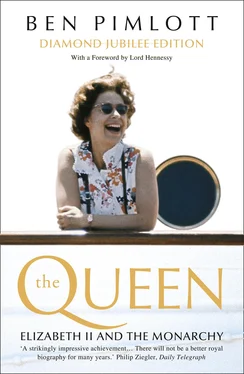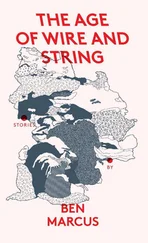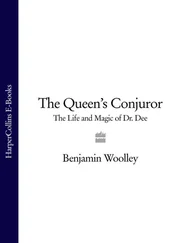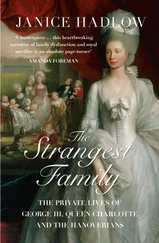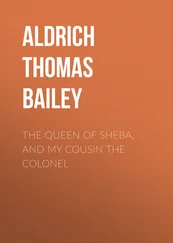Meanwhile, the idea of the Princess as standing for the future was enhanced on June 4th, Derby Day, by the announcement of her pregnancy. The Princess broke precedent by appearing the same afternoon, ‘smiling and unabashed,’ at the Epsom Downs racecourse. 25No child in utero arouses more interest than a royal one in the direct line. As Crawfie later pointed out, the only truly private period in the existence of a member of the Royal Family is between conception and the moment when the coming event is publicly known. 26For Prince Charles, that period was now over. The world’s most famous foetus became the hapless recipient of baby clothes from all over the world, together with matinée coats, bootees and pictures of storks.
PRECEDENT was about to be broken in another way: the custom that had got ‘Jix’ Joynson-Hicks out of bed in the middle of the night in 1926 was discontinued. Royal propaganda presented the decision as an independent initiative by the King and Queen, and further evidence of their modernity. In fact, it only came about after a fight, and the forces of reaction nearly won the day.
Lascelles later claimed to have been the instigator of change. ‘I had long thought that the practice of summoning the Home Secretary to attend, like a sort of supernumerary midwife, at the birth of a royal baby was out-of-date and ridiculous’, he wrote in 1969, after his retirement. ‘The Home Office made exhaustive researches and assured me that it had no constitutional significance whatever, and was merely a survival of the practice of ministers and courtiers, who would flock to the sick-bed, whenever any member of the Royal Family was ill.’ 27The Home Office assurance was indeed categorical. ‘The custom is only a custom,’ Chuter Ede, the Home Secretary, wrote in June. ‘It has no statutory authority behind it and there is no legal requirement for its continuance.’ 28
It was an opportunity to do away with a time-wasting and embarrassing distraction. The matter was one for the King, but the King demurred. According to Lascelles’s later account, when he put the proposition to him in the autumn of 1948, George VI agreed at once, ‘but the Queen thought differently, seeing in this innovation a threat to the dignity of the Throne. So I was told to hold my hand.’ 29However, Lascelles’s memory of what happened was not exact. Contemporary records suggest that a period of indecision preceded the royal negative. Correspondence in the Royal Archives includes a letter from Lascelles himself to the Home Secretary, written at the end of July, putting off an answer. In it he explained that the King had been particularly busy lately, ‘but hopes to give his full consideration to the question of your attendance at Princess Elizabeth’s accouchement when he gets to Balmoral next week.’ It was another month before the period of full consideration was complete, and the verdict communicated. ‘It is His Majesty’s wish’, wrote Lascelles on August 21st, ‘that you, as Home Secretary, should be in attendance when Princess Elizabeth’s baby is born.’ 30There the matter rested until November when, a few weeks before the birth, the King changed his mind. The clinching factor was not a sudden progressive impulse, or a newly acquired desire to dispense with a meaningless ritual – but a shocked discovery of the constitutional implications of hanging on to it.
What turned the tables was a visit to the Palace, on other business, by the Canadian High Commissioner. In the course of the conversation with the King’s private secretary, the envoy happened to speak of the Princess’s condition. Since the Dominion governments had as much stake in the birth of a future heir as the British one, he remarked, he supposed that when the baby arrived, he and the representatives of the other Dominions would be asked to attend, along with the British Home Secretary. It was a eureka moment. The point had never occurred to Lascelles, to the Home Office, to the Dominion Governments or – apparently – to anybody at all in 1926, at the time of the Princess’s birth. However, constitutionally it was indisputable – and, at a time of Commonwealth transition, politically it was unavoidable.
When Lascelles spoke to the King later that day, he was able, quite casually, to mention that ‘as he had no doubt realized, if the old ritual was observed, there would be no less than seven Ministers sitting in the passage.’ 31The perpetuation of a custom popularly believed to involve the Home Secretary attending ‘as a sort of super-inspector to guarantee that the Royal baby is not a suppostitious child!’ could scarcely be seen as an act of homage 32– least of all, if there were seven super-inspectors. According to Lascelles, the King was horrified at such a prospect, and his resistance immediately crumbled. 33On November 5th, Buckingham Palace announced the ending of ‘an archaic custom’. 34
Perhaps a more personal factor also affected the Monarch’s judgement. The King had been unwell for some time, and in the autumn of 1948 his health took a sharp turn for the worse. On October 30th, a medical examination showed that he was seriously ill. Thirteen days later, his doctors firmly diagnosed early arteriosclerosis – with such a severe danger of gangrene to his right leg that they considered amputating it.
How much did the Princess know? The full significance of the diagnosis may have been kept from her, as it was from the King. However, the physical discomfort of her father, and the acute anxiety of her mother, must have communicated themselves to her during the last few days before her first confinement. 35
The burdens of being a monarch were not easily shed. Despite his illness, and the concern for his survival, the King was required to perform a constitutional function which the courtiers regarded as urgent. ‘As things stand at present,’ Lascelles wrote to the King on November 9th, while the doctors were considering their provisional diagnosis, ‘Princess Elizabeth’s son would be “Earl of Merioneth”, her daughter “Lady X Mountbatten”.’ To ensure that the child would be known, instead, as HRH Prince X or Princess Y, Letters Patent had to be prepared ‘ before the baby is born,’ Lascelles stressed, ‘so that the official announcements may refer to him, or her, as a Prince or Princess.’ 36The King did as he was advised, and Letters Patent were rushed through and issued the same day. The move had an incidental consequence: it finally resolved, for the benefit of constitutional purists, an issue first raised after the birth of Princess Margaret, when it had been argued that the two princesses might have equal claims to the succession. By placing Princess Elizabeth in the same position as if she were the King’s son and heir, any theoretical doubt on this point was finally eliminated. 37
With Clarence House not ready and Windlesham Moor unsuitable, arrangements were made for the Princess’s confinement to take place at Buckingham Palace, just below her second floor bedroom, looking out towards the Mall. The American press reported ‘medical reasons’ for expecting the baby to be a girl 38and a Ceylonese astrologer sent a horoscope – which Lascelles passed to the King for his amusement – promising a boy. 39The astrologer was right. The Princess went into labour early in the evening of November 14th, and – attended by four doctors – gave birth to a baby boy shortly after 9 o’clock. Her husband, who played a game of squash during her contractions, was summoned from the Palace court immediately after the delivery to hear the news. 40According to the official statement, the Duke ‘went into the Princess’s room to see her’ and then ‘went to see his son, who had been taken to the nursery.’ 41Meanwhile, the crowd outside the Palace, far greater than the little gathering in Bruton Street twenty-three years before, became so large that the police had to cordon off the road. Despite appeals for quiet, the cheering continued until after midnight. ‘The bells rang, and a man going down the street outside our flat called “It’s a boy,”’ recorded Hugh Dalton. Pondering the future for such a child, and the future of the British Monarchy, he added: ‘If this boy ever comes to the throne . . . it will be a very different country and Commonwealth he’ll rule over’. 42
Читать дальше
